Every guide book says it. Every web site says it, too. And every person who’s ever been there insists that when visiting Chiang Mai, you must absolutely visit Wat Doi Suthep. So on my last full day in Chiang Mai I decided I had to make the effort, regardless of the fact that it was still raining.
The full name of this temple is Wat Phrathat Doi Suthep Rajvoravihara and it is located atop the mountain that overlooks Chiang Mai, some 17 kilometers from the town. The few Tuk-Tuk drivers I’d talked to all wanted between 400 and 600 baht ($12-18 dollars) for the round trip, which is an exorbitant amount. Instead, I’d discovered that you could take a taxi to Chiang Mai University on the outskirts of town for about 40 baht. In front of the University is a taxi stand where people gather to go up to Doi Suthep. When eight people have collected, the taxi makes the trip up for 40 baht and comes back down again for 30 baht.
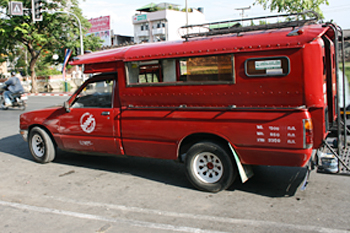
In Chiang Mai the taxis are red pickup trucks that have been converted to contain two long benches on either side of the truck bed with an awning overhead. They tool around town, beeping at anyone they believe could be a potential customer. You just hail one traveling in the general direction you want to go, tell the driver your destination, negotiate a fare, and off you go. I’m not a bad negotiator but being a ‘farang’ (white foreigner) puts me at a distinct disadvantage, so I felt pretty good when I negotiated a fare of 50 baht to get to the University. Once there I had to wait about 40 minutes for enough people to arrive to make it worth the driver’s time – he finally assented to go when we had six people and we all agreed to pay him 50 baht instead of 40.
The road up the mountain is narrow and especially curvy and our driver was a madman. With each curve I was thrown against the person next to me. I made the mistake of looking out the open back of the taxi as it made its way up the mountain and in no time I was motion sick. Closing my eyes and gritting my teeth I muttered to myself, “I will not throw up, I will not throw up, I will not throw up.” We arrived in the nick of time. One more curve and my taxi-mates would have been in barf hell. My motion sickness was so bad that I was literally woozy and off balance, but I decided to tackle the steps to the top of the mountain anyway, figuring I could walk off the dizziness. I hoped this place measured up to its reputation. I was not disappointed. As if to appease the Gods, even the sun came out at the top of the mountain!
According to legend, holy relics discovered during the reign of King Kuena (1355-1385) were placed in a howdah (an ornate carriage) on the back of a white elephant. The elephant was allowed to wander freely until coming to a stop, the resting place presumed to be the most auspicious place to build a temple. Some stories have it that the elephant grew tired on the top of Doi (mountain) Suthep and sat down to rest; others that the elephant dropped dead due to fatigue from the long journey. In any case, the Wat was built upon the elephant’s final resting place.
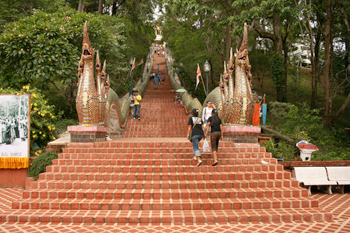
To reach the Wat one mounts 306 steps, which are bordered on both sides by a Naga (serpent), its head at the bottom of the staircase and its scaly body slithering along the top of the balustrade all the way to the top. At the top of the Naga stairway I wandered around the lower plaza surrounding the Wat, eventually reaching the rear of the grounds, where I was treated to a spectacular view of the city from atop the mountain.
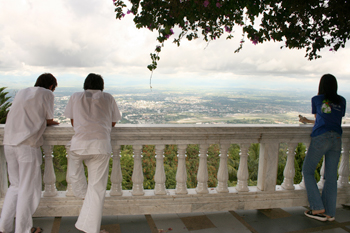

Returning to the front of the facility, I removed my shoes and headed for the stairs to the upper plaza and the temple buildings. Because this stairway is enclosed and fairly steep, there is no view of the Wat from the lower plaza, and I had no idea what to expect. As I mounted this final stairway I was looking down, concentrating on the steep steps, until I finally glanced up at the very top to see the Wat’s Golden Chedi directly in front of me. It took my breath away.
This famous Chedi is 79 feet high, 39 feet across at its base, and is covered with engraved gold plate. On the platform around the Golden Chedi are four ornamental umbrellas, brightly gilded and adorned with filigree decorations, while the walls of the surrounding cloister are painted with murals depicting the life of Buddha. Really, no words can do this Wat justice; it gives new meaning to the phrase, “A picture is worth a thousand words.” I wandered around for several hours and stopped into the Buddhist library to do some reading. I spoke to several monks. I took more than 200 photos. I even wandered into one of the small Viharas, where one monk tied a string around my wrist as he prayed for me and a second monk blessed me by dipping a small straw broom into a vat of holy water and then flipping his wrist in my direction, spraying me three times.

I finally dragged myself away from Doi Suthep around 6 PM. Were it not for the fact that Joan and I had tickets to the Chiang Mai Cultural Center Traditional Dancing exhibition that evening, I might still be wandering that amazing mountaintop. Back at the hotel I quickly changed clothes with only minutes to spare before the van picked us up for the show. Again we checked our shoes at the door and were led to our seats (triangular cushions on the floor), where we sat cross-legged as we were served a dinner of chicken soup, fried chicken, steamed cabbage with pork, fried bananas, steamed rice, sticky rice, and fried pork rounds (you can imagine my delight, vegetarian that I am). While the food left much to be desired, the show was excellent. It featured traditional Northern Thailand dancing, such as the one where the women wear eight-inch metal fingertips and the chicken dance, where women wear short little tails and chicken hats (hysterical).
A number of tribal dances were also performed, including the rice threshing dance, the war dance, the Akha friendship dance, a dance where children step-hopped in between lengths of bamboo that were being clacked together in time to the music, and a dance that featured an absolutely gorgeous woman in an equally gorgeous costume that billowed out behind her like a peacock’s tail.
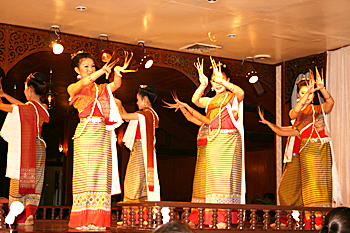
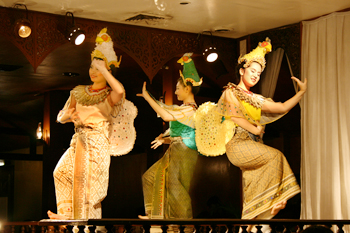

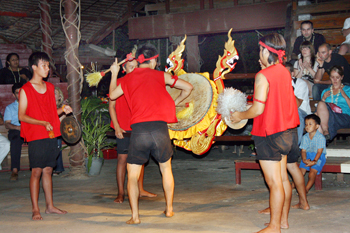
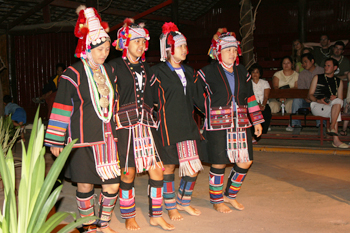



Upon returning to the hotel at 10 p.m. I headed back out. I’d finished reading all the books I brought along and wanted to exchange them at the bookstore just down the street, so I hit the bricks one last time. The first three bookstores were closed but I knew of a fourth one, just across the plaza in front of the Thapae gate leading into the Old City. As I approached the plaza I saw a small crowd gathered in a circle. They were struggling with something in the center of the circle – it looked like a yellow cylindrical kite, about three feet high and 18 inches in diameter. Suddenly they let go of the cylinder with a collective Ahhh! as it floated up into the sky. They had been struggling to light the fuel that is contained in a metal holder at the bottom of the lantern (rather like a can of Sterno). Once the fuel is ignited, the flimsy paper lantern is supported and kept away from the flame until the heat from the flame fills the interior of the lantern, quite like a hot air balloon. At the crucial moment when the air inside becomes lighter than the air on the outside, the lantern is launched. I looked up, following the ascent of the lantern I the night sky, and realized there were two more that had been launched previously. They floated higher and higher, each a dot of light that grew smaller and smaller until they vanished from sight. I watched them launch at least ten more, each time to the accompaniment of joyous Ahhhs! and Ooohhhs! When I inquired about the significance of these lanterns the group explained that it was for good luck, and that the lanterns can be purchased at any local store. Imagine standing in a central plaza in New York City, lighting and launching lanterns such as these. It would never happen. In Thailand, nobody even raised an eyebrow and I love that about this country. I do, however, wonder what happens when the lanterns run out of fuel and fall to the ground, bonking some poor, unsuspecting farmer on the head as he plows his fields.

I caught one of the lanterns as it fell on the deck outside our hotel…but it was too unwieldy to put into the luggage. Chiang Mai is one of my favorite places in the world. Happy that you enjoyed it!
Wow! I had forgotten how many stairs there are at Doi Suthep! We climbed up in 1969 when we were both much younger and more agile. I admire your courage and your fortitude. Take care and be well. Karen